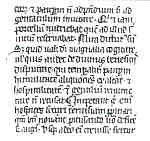POLAND IN THE EARLY CHRONICLES
History's Written Sources
In the writing of history, historians rely on what are called written sources, that is items such as chronicles, Vitae (biographies), letters, capitularies (civil or ecclesiastical ordinances), necrologies, etc. In the case of Poland, a state in which writing was not used prior to the introduction of Christianity, the number of such sources dealing with its early, medieval period is minimal. What exists was written and transcribed by hand, for printing was not invented until centuries later, and, of course, in Latin, the literary language of the Middle Ages.One of the earliest sources about Poland is the Geography of Alfred the Great. Alfred, who died in 901, was King of Britain. In his Geography, he makes some brief references to the Poles living beyond the Vistula. Another one of the earliest sources are the writings of Ibrahim-ibn-Jakub. Ibrahim was a merchant from Spain or perhaps North Africa who visited Bohemia in the mid- tenth century. While he did not visit Poland itself, he refers to it in his account of the Slays of central Europe.
More extensive and more detailed are the writings of two German chroniclers, Widukind, who died in 973 and bishop Thietmar of Merseburg, who died in 1018. Widukind was a German from Saxony, and a Benedictine monk. While his Chronicle is primarily concerned with Saxon affairs, he frequently refers to Poland and is the source of much infonnation about the times of Mieszko I. More extensive than Widukind is the Chronicle of Thietmar. Because he lived into the early eleventh century, Thietmar was better informed about the development of Poland under Mieszko and Boleslaw. The chronicles of Widukind and Thietmar are credited with a significant degree of accuracy. In both chronicles, however, one can detect a pro-German bias and anti-Polish sentiments.
 Chronicle of Gallus Anonimus (fragment) |
Wincenty Kadlubek lived in the late twelfth century, early thirteenth century, dying in 1223. Wincenty had studied as a young man in the leading centers of learning of his thy, namely, Padua and Bologna. He returned to Poland becoming bishop of Cracow. His Chronicle is farther removed from the first years of Polish history. Some historical inaccuracies and personal prejudices mar an otherwise important inventory of the early Polish state.
Such sources as exist about the early years of Polish history, have been collected, edited and published in the late nineteenth century by August Bielowski in the multi-volume Monumenta Poloniae Historica. Later Polish historians - to the present day - have added additional volumes to Bielowski original compendium. An example of an addition is the Catalogue of the Bishops of Cracow which was published in 1978, edited and annotated by Józef Szymański.
Because of the paucity of written sources, historians have turned to the science of archeology to provide them with additional, relevant information. The finding at archeological sites in Poland have been brilliantly presented by Professor Józef Kostrzewski, himself an archeologist. His Początki Cywilizacji Polskiej (Origins of Polish Civilization) is a classic. It results from his own archeological excavations carried out in Poland before the Second World War. More recent, post-war findings are reflected in the writings of Professor Witold Hensel: Początki Państwa Polskiego (The Beginnings of the Polish State) and Początki Polski (The Birth of Poland).
Some other important studies about the beginnings of Poland that have appeared include Professor Kazimierz Tymieniecki's Polska w Średniowieczu which, while more modest in size, reflects sound scholarship. Other important and specific works include Stanisław Zakrzewski's Bolesław Chrobry Wielki, 1925, Stanisław Ketrzyński's Kazimierz Odnowiciel, 1899, Gerard Labuda's Mieszko II, Król Polski, 1922 and Zygmunt Wojciechowski's Mieszko I and the Rise of the Polish State, 1936.
The topic of the early history of Poland is not a limited topic. It has been written on extensively by Polish scholars, Professor Henryk Lowmiański, for one, has written an eight volume set of solid packed text. It represents the glory of Polish scholarship. It, like much of the other literature on the topic, is written, however, in Polish, a language few medievalists can read. So access to all this material about the beginnings of the Polish state is very limited and remains a terra incognita for most medievalists. This is reflected in the textbooks they write. For instance, the Oxford Medieval History, one of the better textbooks, has very little to say about Poland, almost as if Poland were not part of the medieval world, as if had had no influence in Medieval Europe.
| Info-Poland a clearinghouse of information about Poland, Polish Universities, Polish Studies, etc. |